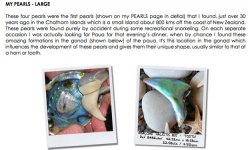Hi everybody ! Can you help ? I am wondering about the horn shape rather common with abalone pearls, and how and why pearls grow in this peculiar shape.
I quite understand that this horn shape is consistent with the shape of the gonad, as very well shown on a picture of this link :
http://www.abalonepearls.co.nz/about.html
But then I cannot make out precisely what happens when the pearl forms. Is the gonad wrapped in nacre ? Does the pearl come in between the gonad and another organ ? Are these pearls hollow because the organic part of the gonad ends up into disintegrating ?
And, would you say that these pearls are more fragile than others, if they are not made of nacre layers until the core ?
Any opinion welcome, thank you !
I quite understand that this horn shape is consistent with the shape of the gonad, as very well shown on a picture of this link :
http://www.abalonepearls.co.nz/about.html
But then I cannot make out precisely what happens when the pearl forms. Is the gonad wrapped in nacre ? Does the pearl come in between the gonad and another organ ? Are these pearls hollow because the organic part of the gonad ends up into disintegrating ?
And, would you say that these pearls are more fragile than others, if they are not made of nacre layers until the core ?
Any opinion welcome, thank you !

